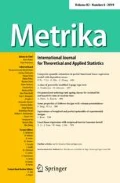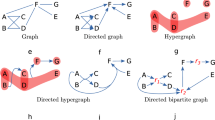Abstract
Latin hypercube designs are widely used in designing computer experiments. In recent years, nested orthogonal Latin hypercube designs have been proposed in the literature. In this article, two general methods of constructing nested orthogonal Latin hypercube designs have been developed. The methods give many new nested orthogonal Latin hypercube designs with fewer number of runs as compared to existing nested orthogonal Latin hypercube designs.
Similar content being viewed by others
References
Cioppa TM, Lucas TW (2007) Efficient nearly orthogonal and space-filling Latin hypercubes. Technometrics 49(1):45–55
Dey A, Sarkar D (2016) A note on the construction of orthogonal Latin hypercube designs. J Combin Des 24:105–111
Georgiou SD, Efthimiou I (2014) Some classes of orthogonal latin hypercube designs. Stat Sin 24:101–120
Lin CD, Bingham D, Sitter RR, Tang B (2010) A new and flexible method for constructing designs for computer experiments. Ann Stat 38(3):1460–1477
Mandal BN, Dash S, Parui S, Parsad R (2016) Orthogonal latin hypercube designs with special reference to four factors. Stat Probab Lett 119:181–185
McKay MD, Beckman RJ, Conover WJ (1979) Comparison of three methods for selecting values of input variables in the analysis of output from a computer code. Technometrics 21(2):239–245
Parui S, Mandal BN, Parsad R, Dash S (2018) Orthogonal Latin hypercube designs for three columns. Utilitas Math 108:149–158
Qian PZG (2009) Nested latin hypercube designs. Biometrika 96(4):957–970
Qian Z, Seepersad CC, Joseph VR, Allen JK, Wu CJ (2006) Building surrogate models based on detailed and approximate simulations. J Mech Des 128(4):668–677
Sun F, Liu M-Q, Lin DKJ (2009) Construction of orthogonal Latin hypercube designs. Biometrika 96:971–974
Sun F, Liu M-Q, Lin DKJ (2010) Construction of orthogonal Latin hypercube designs with flexible run sizes. J Stat Plan Inference 140(11):3236–3242
Sun F, Tang B (2017) A general rotation method for orthogonal latin hypercubes. Biometrika 104(2):465–472
Yang J, Liu M-Q, Lin DKJ (2014) Construction of nested orthogonal latin hypercube designs. Stat Sin 24:211–219
Yang X, Yang J, Lin DKJ, Liu M (2016) A new class of nested (nearly) orthogonal latin hypercube designs. Stat Sin 26(3):1249–1267
Ye KQ (1998) Orthogonal column Latin hypercubes and their application in computer experiments. J Am Stat Assoc 93(444):1430–1439
Author information
Authors and Affiliations
Corresponding author
Additional information
Publisher's Note
Springer Nature remains neutral with regard to jurisdictional claims in published maps and institutional affiliations.
Appendix: Proof of Theorem 2
Appendix: Proof of Theorem 2
First we prove one dimensional uniformity of the constructed design for each layer. One dimensional uniformity of pth layer is obvious. Consider \((p-1)\)th layer \(L_{p-1}=(2^{p-1}L_1^{*T},2^{p-1}L_2^{*T})\). Since \(n = 0 \text { mod } 4\), let \(n=2^2t\) where t is a positive integer. Then, each column of \(L_{p-1}\) contains elements belonging to set \(\{-(2^{p}t-2^{p-2}), -(2^{p}t-3 \times 2^{p-2}),\ldots ,(2^{p}t-2^{p-2}), (2^{p}t-3 \times 2^{p-2}), -2^{p}t, -(2^{p}t-2 \times 2^{p-2}),\ldots ,2^{p}t, (2^{p}t-2 \times 2^{p-2})\}=\{-2^{p}t, -(2^{p}t-2^{p-2}), -(2^{p}t-2 \times 2^{p-2}),\ldots ,(2^{p}t-2 \times 2^{p-2}), (2^{p}t-2^{p-2}),2^{p}t\}\). Clearly, the elements are equally spaced with spacing \(2^{p-2}\). Consider \((p-2)\)th layer \(L_{p-2}\). It may be verified easily that elements of each column of \(L_{p-2}\) are in the set \(\{-2^{p}t, -(2^{p}t-2^{p-3}), -(2^{p}t-2 \times 2^{p-3}),\ldots ,(2^{p}t-2 \times 2^{p-3}), (2^{p}t-2^{p-3}),2^{p}t\}\), the spacing between the elements being \(2^{p-3}\). On similar lines, elements of each column of ith layer \(L_i, i=1,2,\ldots ,p-1\) are in the set \(\{-2^{p}t, -(2^{p}t-2^{i-1}), -(2^{p}t-2 \times 2^{i-1}),\ldots ,(2^{p}t-2 \times 2^{i-1}), (2^{p}t-2^{i-1}),2^{p}t\}\) with spacing \(2^{i-1}\) between the elements. Proof of orthogonality is straightforward extension of the proof of orthogonality given in Theorem 1. Also, \(L_p \subset L_{p-1} \subset \ldots \subset L_2\subset L_1\). This completes the proof.
Rights and permissions
About this article
Cite this article
Dash, S., Mandal, B.N. & Parsad, R. On the construction of nested orthogonal Latin hypercube designs. Metrika 83, 347–353 (2020). https://doi.org/10.1007/s00184-019-00721-w
Received:
Published:
Issue Date:
DOI: https://doi.org/10.1007/s00184-019-00721-w




